下午參加明治大學舉辦的關於中國問題的內部討論會,提出重新評價鄧小平和六四為何一定要用開槍這樣的極端方式兩個問題。
見到景仰已久的日本中國研究的學界大佬矢吹晉先生。
Cultural Revolution of Peking University (1993)
ISBN: 4000020498 [Japanese Import] Tankobon Hardcover
| Title | 北京大学の文化大革命 |
| Authors | Uwe Richter, 貞昭·渡部 |
| Publisher | 岩波書店, 1993 |
| ISBN | 4000020498, 9784000020497 |
| Length | 390 pages |
The cultural revolution at Peking University
Hundred day war: the cultural revolution at Tsinghua University
http://1000ya.isis.ne.jp/0869.html
安藤正士・太田勝洪・辻康吾

文化大革命と現代中国
岩波新書 1986
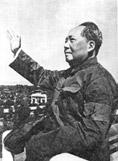
紅衛兵の腕章を贈られた
毛沢東
毛沢東
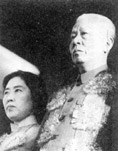
劉少奇と夫人王光美
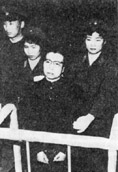
特別法廷で無実を叫んだ江青
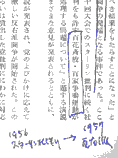
セイゴオマーキング
「百花斉放・百家争鳴運動」
「百花斉放・百家争鳴運動」

墜落したトライデント機と
林彪の遺体
林彪の遺体
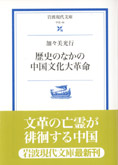
『歴史のなかの
中国文化大革命』
加々美光行著
岩波現代文庫 2001
中国文化大革命』
加々美光行著
岩波現代文庫 2001
1, 《文化大革命的起源》 (The Origins of the Cultural Revolution)共三卷:《人民內部矛盾1956--1957年》、《大躍進1958--1960年》和《浩劫的來臨1951--1966年》。
[美]馬若德(Roderick MacFarquhar)著,中文譯本2012年11月由香港新世紀出版社出版。
馬若德因此書在1999年獲得倍受尊敬的"亞洲研究學會""萊文森獎"(Joseph R. Levenson Prize)。這部專述文化大革命起源的編年通史,從文革前10年的1956年寫起,到1966年文革爆發時止,對來自官方與民間的海量歷史資料條分縷 析,多方考證,細緻甄別,以迥異於黨史話語體系的敘事結構,從國家政治的角度貫通了文革起源的因果鏈條,其旁徵博引的史料之多,所述的歷史事件之多,在中 外文革研究領域中,尚不見出其右者。(推薦人:董郁玉,資深媒體人)

《文化大革命的起源》
有興趣 因為昨晚看 現在搞不清楚何時開始有紅衛兵 (我弄錯1966.5 清華大學.....所以1967.1.26 沒問題)
-----
他媽的文革故事
彭浩翔編《碎碎唸》(CUP,2011),收集文革遺事。編者微博公開要求貼上聽來的文革經歷,一百四十字,留下細碎故事。這些故事如王國維所說「余愛以血書者」,文革之事,真所謂以血書者也。繙讀《碎碎唸》可能會對其中過於荒誕的故事產生懷疑,不知其真假。一段瘋狂歲月,或者說荒誕十年,悲劇就是悲劇,對個人而言,決不至還有辦法再言「小悲劇」了。
----
矢吹晉說,現在的局勢是突出了日美孤立,但是美國是『瘦死的駱駝比馬大』,而且美國還存在通過世界銀行等與中國調整關係的可能性。
「真正悲哀的只有日本,安倍政權說『俯瞰地球儀外交』、『圍堵中國』等豪言壯語,結果是以外交完全失敗告終」
翻讀『文化大革命』(講談社現代新書、1989年--by 矢吹 晋(やぶき すすむ、1938年 - )は、中国研究家。横浜市立大学名誉教授。
略歴 [編集]
東洋経済新報社、アジア経済研究所を経て、横浜市立大学商学部教授となる[1][2]。中国経済論と現代中国論が専攻分野である[2]。また、中国関連の著作を少なからず出している。2004年横浜市大定年退官、名誉教授[2]。
著書 [編集]
中国関連 [編集]
- 二〇〇〇年の中国 論創社, 1984.10.
- チャイナ・ウオッチング 経済改革から政治改革へ 蒼蒼社, 1986.10.
- チャイナ・シンドローム 限りなく資本主義に近い社会主義 蒼蒼社, 1986.12.
- 「図説」中国の経済水準 蒼蒼社, 1987.12.
- 中国開放のブレーン・トラスト 蒼蒼社, 1987.2.
- ポスト鄧小平-改革と開放の行方 蒼蒼社, 1988.3.
- 『文化大革命』(講談社現代新書、1989年
- ペキノロジー 世紀末中国事情 蒼蒼社, 1991.6.
- 保守派vs.改革派 中国の権力闘争 蒼蒼社, 1991.11. 蒼蒼スペシャル・ブックレット
- 『毛沢東と周恩来』講談社現代新書、1991年
- <図説>中国の経済 蒼蒼社, 1992.8.
- 鄧小平 1993.6. 講談社現代新書 のち学術文庫
- 鄧小平なき中国経済 蒼蒼社, 1995.2.
- 巨大国家中国のゆくえ 国家・社会・経済 東方書店, 1996.6.
- 中国人民解放軍 1996.7. 講談社選書メチエ
- 『「朱鎔基」中国市場経済の行方』(小学館文庫、2000年4月)
- 『中国の権力システム - ポスト江沢民のパワーゲーム』(平凡社新書、2000年
- 中国から日本が見える ウェイツ, 2002.10. That’s Japan
- 日中の風穴 未来に向かう日中関係 勉誠出版, 2004.9. 智慧の海叢書
- 『激辛書評で知る中国の政治経済の虚実』(日経BP社|2007年5月)ISBN 9784822245832
- 『図説 中国力』(蒼蒼社、2010年2月)ISBN 9784883600885
朝河貫一研究 [編集]
- 『朝河貫一とその時代』(花伝社、2007年12月)ISBN 9784763405081
- 『日本の発見 - 朝河貫一と歴史学』(花伝社、2008年12月)
共編著 [編集]
- 中国石油 その現状と可能性 編. 竜渓書舎, 1976.
- 中国のペレストロイカ 民主改革の旗手たち 編. 蒼蒼社, 1988.8.
- 『天安門事件の真相』編著(蒼蒼社、1990年
- 中国情報用語事典 1996-97年版 竹内実共編. 蒼蒼社, 1996.10.
- 「図説」中国の経済 第2版 スチーブン・M.ハーナー共著. 蒼蒼社, 1998.2.
- 客家と中国革命 「多元的国家」への視座 藤野彰共著. 東方書店, 2010.11.
- 一目でわかる中国経済地図 編. 蒼蒼社, 2010.9.
- 複眼中国 現代中国の襞を読み解く 時事ニュースJanet 譚ろ美共著 時事通信社, 2010.2. 時事通信オンデマンドブックレット
翻訳 [編集]
- 毛沢東政治経済学を語る ソ連政治経済学読書ノート 現代評論社, 1974.
- 中国社会主義経済の理論 政治経済学基礎知識 竜渓書舎, 1975.
- 思想の積木 毛沢東思想の内容と形式 金思愷 竜渓書舎, 1977.9.
- 中国経済と毛沢東戦略 J.ガーリー 中兼和津次共訳 1978.6. 岩波現代選書
- 中国トロツキスト回想録 中国革命の再発掘 王凡西 柘植書房, 1979.8. アジア叢書
- 改革期中国のイデオロギーと政策 1978~1987 スチュアート・R.シュラム 蒼蒼社, 1987.6
- チャイナ・クライシス重要文献 全3巻 編訳. 蒼蒼社, 1989 蒼蒼スペシャル・ブックレット
- 中国における人権侵害 天安門事件以後の情況 アムネスティ・インターナショナル&アジア・ウオッチ 福本勝清共訳 蒼蒼社, 1991.3.
- 周恩来『十九歳の東京日記』編 鈴木博訳 1999.10. 小学館文庫
- ポーツマスから消された男 朝河貫一の日露戦争論 著・編訳. 東信堂, 2002.2. 横浜市立大学叢書
- 入来文書 朝河貫一 柏書房, 2005.8.
- 大化改新 朝河貫一 柏書房, 2006.7.
- 朝河貫一比較封建制論集 編訳. 柏書房, 2007.2.
- 劉暁波と中国民主化のゆくえ 加藤哲郎・及川淳子共著訳. 花伝社 2011.4.
脚注 [編集]
- ^ a b c PHP研究所人名事典 矢吹晋
- ^ a b c 21世紀中国総研 - 矢吹晋
外部リンク [編集]
Japan and U.S. Ignored Chinese Signals and History, Blundering into the ...
Forbes
...I have been reminded of China Crosses the Yalu as I have worked through the new book on the Senkaku/Diaoyu island crisis by Yabuki Susumu (矢吹晋), professor emeritus of Yokohama City University, one of Japan’s most eminent China scholars. The book (written in Japanese) is entitled:「尖閣問題の核心 」(The Core of the Senkaku Issue), and bears a subtitle:「日中関係はどうなる」 (What is to Become of Japan-China Relations). I believe that the book is the fairest and most objective, as well as the most thorough, exposition of the positions of both Japan and China, and–critically–the U.S., on the Senkaku/Diaoyu islands dispute.
At the risk of oversimplifying, I think I can summarize Professor Yabuki’s analysis and conclusions as follows:
- The Japanese position on the Senkaku/Diaoyu issue is indefensible on several counts, including most fundamentally Japan’s unconditional acceptance of the terms of the Potsdam Declaration (which required the return of all territories “stolen” from China).
- The Meiji government’s annexation of the Ryuku Islands (theretofore an autonomous kingdom) in January 1885, within which the Senkaku/Diaoyu islands were identified, followed three months later by the Qing Dynasty’s surrender of Taiwan and the Pescadores to Japan in the Treaty of Shimonoseki (ending the Sino-Japanese War) are both mooted by the terms of Potsdam. The islands were and are clearly part of Taiwan, which in addition has the most legitimate claim to continuous use/occupation.
- The Japanese position that Senkaku/Diaoyu is part of Japanese territory because it was awarded to Japan by the U.S. in the Okinawa Reversion agreement of 1971 is similarly contrary to fact. The U.S. awarded to Japan only administrative authority over the islands, not sovereignty. Sovereignty was specifically not transferred. The U.S. continued to maintain was undetermined between the three claimants and would only be determined through discussion and agreement. (As I noted in the last post, the Obama administration–in a monumental blunder–effectively changed this policy by failing to object to and stop Japanese “nationalization.”)
- Japanese policy–and particularly public misunderstanding–has been based on the false assertion, uttered by then foreign minister Fukuda Takeo in testimony to the Upper House of Diet on December15, 1971 that Okinawa Reversion had accomplished the restoration of Japanese sovereignty over the Senkaku/Diaoyu islands. Whether Fukuda misunderstood the issue, or intended to deliberately deceive the country through this testimony is unclear.
- The Chinese position on handling the territorial issue was, before Japanese “nationalization,” grounded on the 1972 agreement between Prime Minister Tanaka Kakue-Premier Zhou Enlai, when the terms of Japan-China diplomatic relations were determined, to “shelve” the issue–i.e., to avoid any acts that sought to enforce one side’s claim to sovereignty.
- Yabuki cites his own research and authoritative third party sources to charge that the Japanese Ministry of Finance removed from official transcripts of the Tanaka-Zhou discussions that agreement to “shelve” the issue, allowing future Japanese governments to fraudulently claim that the issue was not discussed and that China asserted a claim over the islands.
- Under the circumstances above, the decision of the Noda government to “nationalize” the islands was a grave provocation, a fundamental change in the status quo, tantamount from the Chinese point of view to aggression and forceful annexation of Chinese territory. An equivalently forceful Chinese response to “balance” the level of its sovereign claim was inevitable.
Professor Yabuki chronicles the many signals of trouble as Chinese concern over the direction of Japanese policy grew. These included the refusal of Hu Jintao in February in to meet a top level delegation of seven of Japan organizations’ heads in Beijing to commemorate the 40th anniversary of restoration of diplomatic relations. The last minute cancellations of a scheduled visit to Hu Deping, son of Japan’s last “sympathizer” in the Beijing leadership, Hu Yaobang, and a visit of China’s most senior uniformed military officer, Guo Boxiong, in May.
What concerns Yabuki most is that these signals, among many others, were hardly noticed or appreciated in Japan. Yet, they were leading to what became almost a complete breakdown in communications with China. The almost farcical, but deeply tragic, denouement of this breakdown was the “16 minute standing dialogue” between Hu Jintao and Noda held on the sidelines of the APEC conference in Vladivostok on September 9 at which each side delivered its ultimatum.
The Noda Cabinet decided the next day to implement nationalization and the following day paid the money and signed documentation. It is now very hard to believe that anyone expected Japan’s decision to have the effect of de-escalating the crisis. If anyone did they were making the same mistakes as Truman and MacArthur in 1950.


沒有留言:
張貼留言